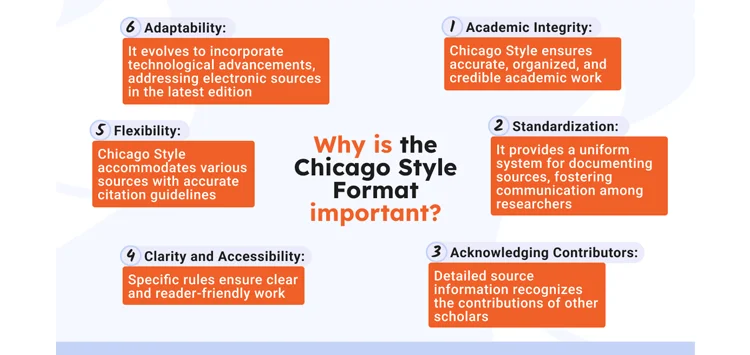Chicago In Text Citations Assignment Help
Chicago style in-text citations play a crucial role in academic writing, ensuring proper acknowledgment of sources and maintaining scholarly integrity. When crafting academic papers in accordance with Chicago style, correctly implementing in-text citations is essential to avoid plagiarism and provide clear references for readers to locate the original sources.
In Chicago style, in-text citations can take two primary forms: the author-date system and the footnote/endnote system. The author-date system involves including the author's last name and the publication year within parentheses after the cited information, while the footnote/endnote system requires superscript numbers in the text, which correspond to full citations in footnotes or endnotes.
For students navigating the complexities of Chicago style in-text citations, assistance is often sought, particularly in the form of In-Text Citation Generators. These tools streamline the citation process, allowing students to input relevant information about their sources and generating properly formatted citations according to Chicago style guidelines. In-Text Citation Generator alleviate the burden of manually formatting citations, saving time and ensuring accuracy.
Access to reliable resources and guides on Chicago style in-text citations, coupled with the convenience of In-Text Citation Generators, empowers students to effectively cite sources within their assignments, enhancing the credibility and professionalism of their academic work.
What is a proper in-text citation in Chicago style?
A proper in-text citation in Chicago style serves to acknowledge the sources you have used in your writing, providing specific information that allows readers to locate the full details in your bibliography or reference list. In Chicago style, there are two main methods of in-text citation: the author-date system and the footnote/endnote system.
In the author-date system, the author's last name and the publication year are included in parentheses within the text, typically following the cited material. For example: (Smith 2010). This system is commonly used in the sciences and social sciences.
In the footnote/endnote system, a superscript number is placed after the cited material, and the full citation is provided either as a footnote at the bottom of the page Added as a note at the end of the manuscript. The superscript number correlates with the footnote or endnote containing the full citation details.
Proper Chicago style in-text citations ensure academic integrity by crediting the original authors and sources, avoiding plagiarism, and providing a clear trail for readers to locate the referenced material. Assignment help tutors can assist students in mastering the nuances of Chicago style in-text citations, offering guidance on formatting, placement, and when to use each citation method based on the requirements of the assignment or discipline. By mastering proper citation techniques, students can enhance the credibility and professionalism of their academic work.
How should in-text citations be formatted in accordance with the Chicago style?
In accordance with the Chicago style, in-text citations serve to acknowledge the sources of information used in academic writing. The format for in-text citations varies depending on whether you're using the author-date system or the notes and bibliography system.
For the author-date system, the citation typically includes the author's last name, publication year, and page number, enclosed in parentheses. For example: (Smith 2010, 45). This format is commonly used in disciplines such as the social sciences and natural sciences.
Conversely, the notes and bibliography system, frequently used in the humanities, employs superscript numbers in the text to indicate a citation. These numbers correspond to footnotes or endnotes where the full citation is provided, including author, title, publication information, and page number if applicable.
When seeking online assignment help, students often rely on professional assistance from assignment writers well-versed in citation styles like Chicago.
writers ensure that in-text citations adhere to the prescribed format, thereby maintaining academic integrity and credibility. By employing the expertise of assignment writers familiar with Chicago style guidelines, students can confidently present well-cited papers that meet scholarly standards and contribute to their academic success.
Could you give instances of in-text citations in the Chicago style for various kinds of sources?
In academic writing, adhering to proper citation styles is crucial to acknowledge the sources of information and ideas used within a paper. Chicago style, known for its flexibility and applicability across various disciplines, offers specific guidelines for in-text citations. When seeking assistance with Chicago style citations from a reputable source like BookMyEssay, clarity and accuracy are paramount.
For instance, when citing a book in-text using Chicago style, the author's last name and publication year are typically enclosed in parentheses, like (Smith 2010). In contrast, for online sources lacking page numbers, it's common to include just the author's last name and a shortened version of the title or a URL, such as (Johnson, "Global Warming"). This approach ensures clarity and facilitates easy retrieval for readers.
Moreover, for citations from journal articles, the author's last name, publication year, and page number are included, separated by commas, such as (Brown 2018, 25). This format allows readers to locate the specific information referenced within the text. Additionally, when citing sources like websites, Chicago style may require the inclusion of the author's name, publication date, and if available, a page or paragraph number for direct quotations (Miller, 2019, para. 4).
In essence, seeking online homework help from platforms like BookMyEssay ensures students receive accurate guidance on incorporating Chicago style in-text citations across various source types, ultimately enhancing the credibility and professionalism of their academic work.








 3 Bellbridge Dr, Hoppers Crossing, Melbourne VIC 3029
3 Bellbridge Dr, Hoppers Crossing, Melbourne VIC 3029



